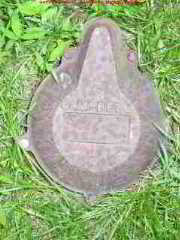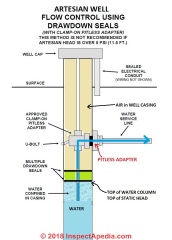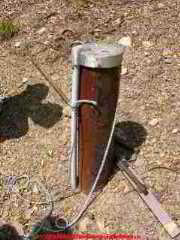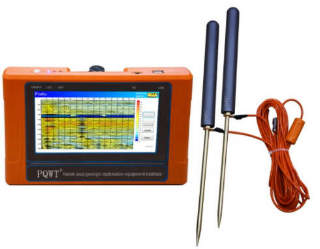 How to Find the Well Where is my water well?
How to Find the Well Where is my water well?
- POST a QUESTION or COMMENT about how to locate the well by a search of the property, of records & sketches, or by using special tools & equipment to find buried components.
How to locate a water well or well casing:
This article describes how to find a water well at a property. We describe a series of steps and methods that can help find the well when its location is otherwise not obvious.
Finding the well without having to dig up the property like a madman can be important when well or well piping, pump, or foot valve repairs are needed or when we need to sanitize or shock the well.
InspectAPedia tolerates no conflicts of interest. We have no relationship with advertisers, products, or services discussed at this website.
- Daniel Friedman, Publisher/Editor/Author - See WHO ARE WE?
Water Well Location - how to find the well

- Start finding your water well by looking inside to find the cold water inlet pipe or water pressure tank in your building. (If you can't find the water pressure tank in your home, note that at some properties the pressure tank may be located outside in a well pit. If that's the case the well pit itself will also contain the well. )
- Find where the water pipe from your well enters the building - usually at a basement or crawl space, or if your home is on a slab, look in your plumbing or utility area.
- Often the water well is located on the same side of the building as that into which the well pipe enters the structure (but not always!)
- Outside, look for a well casing projecting above ground level. If you know where your septic system is located, the well should be somewhere else, 50 to 100 feet away or more.
- Below in response to reader Ted we list more-detailed steps to follow to find your well.
Reader Question: how do I find the well opening?
3/24/2014 Ted said:
How do i know if my foot valve is bad on a two line system. and how do I find the well opening.
Reply: How to Find a Water Well:
Ted,
If your well and pump system keeps losing prime that's a good clue that there may be a bad foot valve (or a leak in well piping).
I can't know where your well is located, but there are some common approaches starting by noticing where well piping exits the building, inspecting the site for places we would NOT put a well (like near a septic field), contacting well drillers to ask who drilled the well (often they have records of its location), inspecting the site for obvious clues (depressions, well casing visible above ground), and ultimately, using equipment to follow well piping.
In addition to some practical suggestions I'll make in a moment, here are some related "how to find" articles that give useful techniques for finding a component that is not in plain sight.
All of these "how do I find ..." topics use similar thinking and approaches, combining a search for records or sketches, an inspection of the site for reasonable locations where the well or septic component or buried tank might be located, and if necessary the use of equipment or even modest excavation.
- At BURIED OIL TANKS, FINDING
we describe how to find evidence of buried oil storage tanks (USTs) by visual inspection. - At SEPTIC TANK, HOW TO FIND
we discuss how to find the septic tank - but similar methods might be used to locate a well whose casing or top is buried and not immediately obvious. If you prefer to watch a video on how we figure out where a septic tank could or could not be located,
see SEPTIC VIDEOS. - Also see SEPTIC DRAINFIELD LOCATION.
- Look on the property for a well casing, cap, or well pit. If inspecting the property itself does not disclose an above-ground, visible well casing and cap then you may have an older well whose casing top was left buried. Look for a steel casing like the one in our photo at above left.
At an older property the casing may be at ground level (photo at above right) or even buried completely, or as we show at our
SEPTIC VIDEOS
the well casing may above ground but not obvious because it's hiding in a clump of bushes.
Look for a pipe of any size sticking up out of the ground. A well casing may vary from 2" to 6" in diameter or more. A driven point water well pipe may be just an inch in diameter.
Look for a pit, vault, or well-pit, constructed of metal, stone, concrete, concrete block, typically with a removable cover, often 3' to 6' across.
Look for long depressions where soil may have settled over a buried water well line between the building and the well pit or well casing. Follow the depression to its end and look there for a water well, casing, or well pit.
Keep in mind that an older well casing top may be completely buried. Look also for a depression in the soil, perhaps just a foot or two in diameter. - Look for locations where a well would be likely to be placed: continue by looking in the building for a sketch of well location - often left in a basement or crawl area over or close to the pressure tank and pump/controls, or sometimes even sketched on a ceiling joist or wall where the well pipe exits the building.
Often in older neighborhoods the same well driller installed all of the local wells and knew about where the aquifer ran at an accessible depth. For example we sometimes find that along a suburban street all of the local water wells are more or less in a line from property to property.
See WELL CLEARANCE DISTANCES for examples of areas where you would not expect to find the well. This data can help focus a search for the actual well location.
If your well is a jetted or driven point well you probably won't find a 6" diameter steel casing but rather a much smaller 1-2" diameter galvanized iron pipe.
See details at DRIVEN POINT WELLS
and JETTED WELLS - Call local well drillers: if that doesn't come up with a sketch of well location, continue by calling all of the well drillers in your area to ask if one of them installed the well.
Attempting to locate a buried well pit cover in New York I called local well drillers. Even though the home had been built in 1924 I found that a local well driller actually recalled the event and could immediately tell me where the well was located - in that case from memory but more often from records. - Check municipal records: for properties served by a community well or well system (as opposed to private wells), both registration and regular testing are required (except for small systems) in most countries including the U.S. Each well will be identified, registered, tested periodically, and the well location as well as recent water test results should be available.
Example: "NUMBERING WATER WELLS in CALIFORNIA", [PDF] California's state well numbering system, "Water Facts No. 7", California Department of Water Resources,
(1 of 4 water district agencies), Northern District 2440 Main Street Red Bluff, CA 96080-2398 (530) 529-7300 www.dpla.water.ca.gov/nd. Retrieved 2017/03/23, original source: http://www.water.ca.gov/pubs/conservation/waterfacts/ numbering_water_wells_in_california__water_facts_7_/water_facts_7.pdf
Illustration: the 300M portable underground water detector -TC300, PQWT-TC300, by Zhongyun, a Chinese corporation who describe the product as a Mapping with One Button Water Detector.
Watch out: a groundwater-detector like the device above may not be suitable for locating a well nor locating the best place to dig or drill a water well.
- Pipe tracing or well locating equipment: well piping can often be traced using pipe locating equipment.
A simple metal detector can often follow buried metal water pipes from the building to the well. But if your well is piped using plastic or ABS piping a metal detector won't help.
A long plumbing snake or pipe inspection camera can trace the water pipe between building and the well location or well casing.
Your local plumbers and some well drillers have electronic equipment that can trace piping. such as a magnetometer or an electro-magnetic anomaly detector that can follow well pipes or spot a buried well casing.
Some people swear by dowsers who use a willow-switch to "follow the water pipe" but in my own research I've not found scholarly studies that support that claim. Most independent studies of dowsers found that their performance in finding water or water wells was no better than random.
- Dig if dig we must: A last resort is a series of small test excavations to follow the well line.
Research on Well Location Methods & Dowsing
- Ballukraya, P. N., R. Sakthivadivel, and R. Baratan. "Inadequacies in theTechnique of Resistivity Method for Location of Waterwell Sites in Hard Rock Areas." Hydrology Research 12, no. 3 (1981): 185-192.
Abstract:
Large scale exploratory work for groundwater in hard rock region of South India has been carried out by the authors during the last ten years, using electrical resistivity method. The standard methods of data interpretation were found to be inadequate in locating water well sites and determining the existence and depth of occurrence of water bearing fractures and joints.
Wenner and Schlumberger type vertical electrical sounding (VES) curves were interpreted by matching against theoretical model curves and also by inverse slope method. The interpreted results were correlated with the actual driller's logs.
No satisfactory correlation could be observed either between the geoelectrical interpreted layer boundaries and the layer boundaries from the wells or between the resistivity in the hard rock and the water yield. A more pragmatic approach to the problem is desirable to minimize the failures of wells in hard rock terrain. - Burridge, Gaston. DOES THE FORKED STICK LOCATE ANYTHING? AN INQUIRY INTO THE ART OF DOWSING [PDF] Western Folklore 14, no. 1 (1955): 32-43.
Excerpt:
DOWSING, SOMETIMES CALLED WATER WITCHING, water divining, doodlebugging, well witching or rhabdomancy, is a most controversial subject. It seems considerably less controversial in Europe than in this country. Dowsing's protagonists swear by it, its antagonists swear at of each. There appear to be many of each, and and each has a great deal to say. Is there any safe middle ground? I think there is. - Gooding, Alice F. "WORTHY OF SCIENTIFIC APPROVAL? EXAMINING THE ACCURACY AND VALIDITY OF DOWSING ROD TECHNIQUES." Georgia Journal of Science 78, no. 1 (2020): 9.
Abstract:
Science or Pseudoscience? Sometimes referred to as Divination Rods or Witching Sticks, Dowsing Rods have been used throughout many centuries to locate various lost items both underground as well as underwater. Regarded as highly controversial now, dowsing was considered an occult practice and has had fluctuating periods of acceptance academically and professionally. Furthermore, dowsing today is rejected as an occupational tool used by most archaeologists.
However, in recent years, there have been some archaeologists who have become advocates for this practice and will use it to aid in excavation. The study seeks to answer the questions: in an archaeological setting, how accurate are Dowsing Rods in locating both material and skeletal archaeological remains? Who is and is not using this practice today? And what are the controversies behind this practice?
The goal of this research is to investigate the accuracy and validity of dowsing rod techniques, uncover who is still using this practice today, and consider the controversies behind the practice. In order to accomplish these goals, interviews will be conducted to investigate who is and who is not using this practice, field research will be used to explore the accuracy behind this practice, and observational studies will be conducted to examine the controversies.
It is expected that this study will contribute to the scientific claims concerning dowsing rods. - Harter, Thomas, WATER WELL DESIGN and CONSTRUCTION [PDF] (2003) University of California, Division of Agriculture and Natural Resources, UC Davis,
Excerpt:
DETERMINING A WELL LOCATION
The location of a well is mainly determined by the well’s purpose. For drinking and irrigation water-production wells, groundwater quality and long-term groundwater supply are the most important considerations.
The hydrogeological assessment to determine whether and where to locate a well should always be done by a knowledgeable driller or professional consultant. The water quality criteria to use for drinking water wells are the applicable local or state drinking water quality standards.
For irrigation wells, the primary chemical parameters of concern are salinity and boron and the sodium-adsorption ratio. - Minnesota DOH, FINDING LOST WELLS: SEARCHING for WELLS on a PROPERTY [PDF], Minnesota Department of Health, Well Management Section, Tel: 651-201-4600 or
800-383-9808
Excerpts:
Unused wells are often visible as a 1¼ inch to 6-inch diameter steel pipe sticking above the ground, the floor of a basement or basement offset, or a well pit. However, older wells may have casing made of concrete, tile, rock, brick, or stone; and many newer wells are cased with plastic pipe. As discussed previously, some wells were originally buried, and if properties have been remodeled, wells may be built over or around, cut off, or buried. ...
Properties with a long history may have more than one well. Farm properties are more likely to have multiple wells to serve barns, irrigation, and other purposes. Well searches generally start with a visual inspection. The information listed under “Physical Evidence” may help find a well.
People familiar with the property may be aware of the property’s history, and may be able to point to “lost” wells. State well records were not required before 1974. However, the Minnesota Geological Survey has collected historic well records where available.
Counties, townships, or cities may have well information with building permit, sewer permit, or property files. In cases where the physical evidence, personal knowledge, or records are absent, some tools may be needed to locate wells. - Ndlovu, Shakespeare, V. Mpofu, D. Manatsa, and E. Muchuweni. MAPPING GROUNDWATER AQUIFERS USING DOWSING, slingram electromagnetic survey method and vertical electrical sounding jointly in the granite rock formation: a case of Matshetshe rural area in Zimbabwe [PDF] Journal of Sustainable Development in Africa 12, no. 5 (2010): 199-208.
Abstract:
A survey was conducted in Matshetshe area, under the Filabusi district of Zimbabwe, to find groundwater by jointly using the Slingram electromagnetic survey method and dowsing method in traversing. The two methods independently managed to locate the same positions of high groundwater potential.
The vertical electrical sounding was then done in the anomalous positions. This was to provide the depth of the weathered layers above the bedrock. Traversing results show that dowsing, an ancient traditional method of exploration, can be used jointly with the modern traversing geophysical methods in finding groundwater.
The study revealed, for more accurate results, that the three methods must be analyzed jointly to overcome the vulnerability of errors linked to a single method. The information from the three methods was used to pinpoint prospective drilling sites for groundwater with a high degree of accuracy. Key Words: Apparent resistivity, Dowsing, Profiling. - Ramirez, B. A., G. J. Joosten, M. P. Kaleta, and P. P. Gelderblom. "Model-based well location optimization–a robust approach." In SPE Reservoir Simulation Conference. OnePetro, 2017.
- Weber, Daniel Brent. The use of capacitance-resistance models to optimize injection allocation and well location in water floods. The University of Texas at Austin, 2009.
...
Reader Comments, Questions & Answers About The Article Above
Below you will find questions and answers previously posted on this page at its page bottom reader comment box.
Reader Q&A - also see RECOMMENDED ARTICLES & FAQs
On 2020-02-05 - by (mod) -
Tyler:
With the water softener on "bypass" you can eliminate that from the "no water" problem.
Before digging up like madmen, let's step through some easier diagnostic procedures starting at
NO WATER PRESSURE https://inspectapedia.com/water/No_Water_Pressure.php
and let me know what you find.
On 2020-02-05 by Tyler
I'm at my buddy's house he said he doesnt have water so we replaced everything on his water softer downstairs rewired it still no water went outside looking for the well cap no where started digging been digging for two days and found the water pipe followed for 16 feet and still no water cap
On 2020-01-15 - by (mod) -
Jackie
With the ducking apology that I can't be as informed nor as smart as your on-site plumber, I can't imagine how he or she knew that you need a new well for-sure from having to replace an above-ground pump.
It is true that IF the well has run dry and you run the pump "dry" it is likely to be damaged and could need replacement.
But you could get that same symptom from repeated loss of prime ( a bad foot valve in the well) or from leaks in well piping between house and well.
Hire a well driller or a more thoughtful plumber to find the well, inspect its water level, and perhaps check the piping and foot valve for leaks.
See
WATER PRESSURE LOSS DIAGNOSIS & REPAIR
as a good place to start figuring out what's happening.
Keep me posted
On 2020-01-15 by Jackie
Had a plumber replace our water pump but still have no water.. He told us I don't know what to tell you other then to call a well driller cause you need a new one. First off how can he tell it's dry and needs a new one. Secondly we paid 500 to have him say this can they leave us with no water.
On 2019-11-24 by Sean jones
Super helpful, thank you very much
On 2019-02-11 - by (mod) -
Judy the article above has my very best suggestions for finding a well - I don't know anything at all about your specific property.
Try those steps and let me know what you find and what questions remain.
On 2019-02-11 by Judy
We can not fine my well any were 757-417-5248
...
Continue reading at WELL CLEARANCE DISTANCES or select a topic from the closely-related articles below, or see the complete ARTICLE INDEX.
Or see WELL LOCATION, HOW TO FIND FAQs - questions & answers about how to find the well, posted originally at the end of this page.
Or see these
Recommended Articles
- SEPTIC CLEARANCE DISTANCES
- WELLS CISTERNS & SPRINGS - home
- WELL CLEARANCE DISTANCES
- WELL DEPTH, HOW TO MEASURE
- WELL LOCATION, HOW TO FIND
- WELLS CISTERNS & SPRINGS - home
Suggested citation for this web page
WELL LOCATION, HOW TO FIND at InspectApedia.com - online encyclopedia of building & environmental inspection, testing, diagnosis, repair, & problem prevention advice.
Or see this
INDEX to RELATED ARTICLES: ARTICLE INDEX to WATER SUPPLY, PUMPS TANKS WELLS
Or use the SEARCH BOX found below to Ask a Question or Search InspectApedia
Ask a Question or Search InspectApedia
Try the search box just below, or if you prefer, post a question or comment in the Comments box below and we will respond promptly.
Search the InspectApedia website
Note: appearance of your Comment below may be delayed: if your comment contains an image, photograph, web link, or text that looks to the software as if it might be a web link, your posting will appear after it has been approved by a moderator. Apologies for the delay.
Only one image can be added per comment but you can post as many comments, and therefore images, as you like.
You will not receive a notification when a response to your question has been posted.
Please bookmark this page to make it easy for you to check back for our response.
IF above you see "Comment Form is loading comments..." then COMMENT BOX - countable.ca / bawkbox.com IS NOT WORKING.
In any case you are welcome to send an email directly to us at InspectApedia.com at editor@inspectApedia.com
We'll reply to you directly. Please help us help you by noting, in your email, the URL of the InspectApedia page where you wanted to comment.
Citations & References
In addition to any citations in the article above, a full list is available on request.
- In addition to citations & references found in this article, see the research citations given at the end of the related articles found at our suggested
CONTINUE READING or RECOMMENDED ARTICLES.
- Carson, Dunlop & Associates Ltd., 120 Carlton Street Suite 407, Toronto ON M5A 4K2. Tel: (416) 964-9415 1-800-268-7070 Email: info@carsondunlop.com. Alan Carson is a past president of ASHI, the American Society of Home Inspectors.
Thanks to Alan Carson and Bob Dunlop, for permission for InspectAPedia to use text excerpts from The HOME REFERENCE BOOK - the Encyclopedia of Homes and to use illustrations from The ILLUSTRATED HOME .
Carson Dunlop Associates provides extensive home inspection education and report writing material. In gratitude we provide links to tsome Carson Dunlop Associates products and services.



